A tree's leaf, a blade of grass, a single algal cell: all make fuel from the simple combination of water, sunlight and carbon dioxide through the miracle of photosynthesis. Now scientists say they have replicated—and improved—that trick by combining chemistry and biology in a "bionic" leaf.
Chemist Daniel Nocera of Harvard University and his team joined forces with synthetic biologist Pamela Silver of Harvard Medical School and her team to craft a kind of living battery, which they call a bionic leaf for its melding of biology and technology. The device uses solar electricity from a photovoltaic panel to power the chemistry that splits water into oxygen and hydrogen, then adds pre-starved microbes to feed on the hydrogen and convert CO2 in the air into alcohol fuels. The team’s first artificial photosynthesis device appeared in 2015—pumping out 216 milligrams of alcohol fuel per liter of water—but the nickel-molybdenum-zinc catalyst that made its water-splitting chemistry possible had the unfortunate side effect of poisoning the microbes.
So the team set out in search of a better catalyst, one that would play well with living organisms while effectively splitting water. As the team reports in Science on June 2, they found it in an alloy of cobalt and phosphorus, an amalgam already in use as an anticorrosion coating for plastic and metal parts found in everything from faucets to circuit boards. With a little charge, this new catalyst can assemble itself out of a solution of regular water, cobalt and phosphate—and phosphate in water actually is good for living things like the Ralstonia eutropha bacteria that make up the back half of the bionic leaf. Run an electric current from a photovoltaic device through this solution at a high enough voltage and it splits water. That voltage is also higher than what is needed to induce the cobalt to precipitate out of the solution and form the cobalt phosphide catalyst, which means when the bionic leaf is running there are always enough electrons around to induce the catalyst's formation—and therefore no excess metal left to poison the microbes or bring the bionic leaf's water-splitting to a halt. "The catalyst can never die as it's functioning," Nocera says, noting that the new artificial leaf has been able to run for up to 16 days at a stretch.
On supporting science journalism
If you're enjoying this article, consider supporting our award-winning journalism by subscribing. By purchasing a subscription you are helping to ensure the future of impactful stories about the discoveries and ideas shaping our world today.
The new cobalt catalyst also splits water into hydrogen and oxygen without creating the kind of reactive oxygen molecules that can damage DNA or other processes essential to continuing life. "I don't know why yet," Nocera says. "That will be fun to figure out."
With this new catalyst in the bionic leaf, the team boosted version 2.0's efficiency at producing alcohol fuels like isopropanol and isobutanol to roughly 10 percent. In other words, for every kilowatt-hour of electricity used the microbes could scrub 130 grams of CO2 out of 230,000 liters of air to make 60 grams of isopropanol fuel. That is better than the efficiency of natural photosynthesis at converting water, sunlight and air into stored energy.
And there is no reason to think that the R. eutropha could not be made to generate other products—perhaps complex hydrocarbon molecules like those found in fossil fuels or even the whole range of chemicals currently synthesized from polluting resources, such as fertilizers. "You have bugs that eat hydrogen as their only food source, and the hydrogen came from solar energy water splitting. So you have renewable bugs and the synthetic biology to make them do anything," Nocera says. "You can start thinking about a renewable chemicals industry." The hybrid team reports in the Science paper that they have already induced R. eutropha to make a molecule that can ultimately be transformed into plastics.
The fundamental idea is to reverse combustion and use a remnant of fossil fuel burning—the CO2 piling up in the atmosphere—to build renewable fuels, just as plants do. But the bionic leaf will not compete on price anytime soon with the fossil fuels dug out of the ground, especially because the microbes do not yet make a lot of fuel quickly. The largest bionic leaf to date is in a one-liter pot, although the team has not discovered any limits to making it bigger.
By knitting fuels out of the excess CO2 in the air, this new bioreactor could help mitigate planet-warming pollution problems while bringing cleaner fuels to people who do not currently have access to modern energy. "This science you can do in your backyard. You don't need a multi-billion dollar massive infrastructure," Nocera says.
"By integrating the technology of biology and organic chemistry there is a very powerful path forward where you take the best of both worlds," he adds. "I took air plus sunlight plus water and I made stuff out of it, and I did it 10 times better than nature. That makes me feel good."
